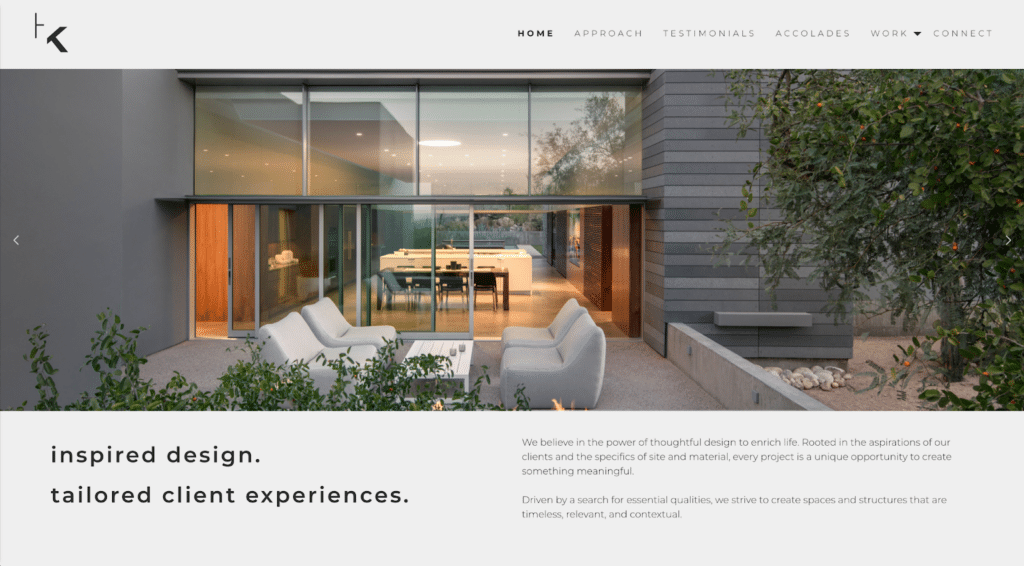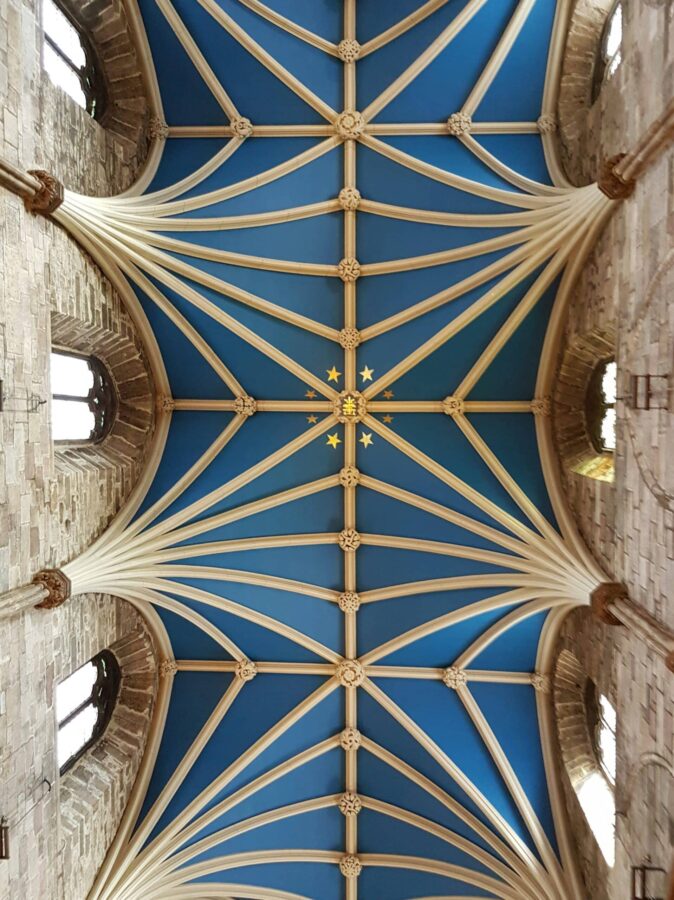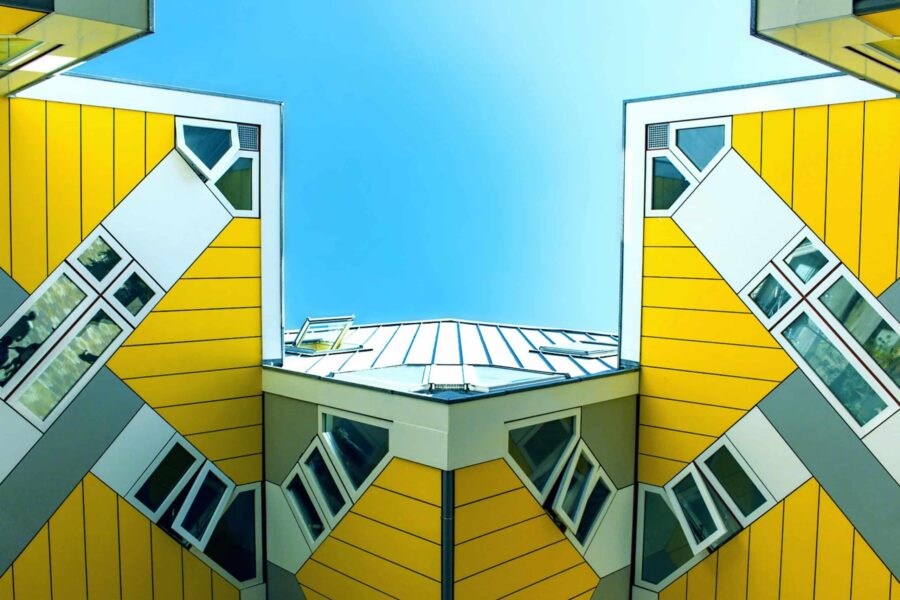Os portfólios digitais tornaram-se ferramentas inegociáveis para artistas e profissionais criativos de todos os tipos, e os arquitetos não são exceção. Neste artigo, forneceremos a você as ferramentas necessárias para criar um portfólio único, desenvolvido especificamente para ajudá-lo a causar impacto e conquistar mais clientes. Desde a curadoria de seus projetos e imagens até a garantia de que o design do seu site seja compatível com suas metas, todas as dicas que você precisa para criar ou atualizar seu portfólio estão aqui.
O poder dos elementos de design exclusivos
Como as fotografias e as maquetes do seu trabalho serão o centro das atenções, é fácil esquecer o impacto que outros elementos de design causam na apresentação geral do seu portfólio. Mas são exatamente esses elementos que unem seu trabalho e fazem com que seu portfólio pareça profissional, memorável e exclusivamente seu.
Vistos em conjunto, os elementos de design do seu portfólio de arquitetura fornecem aos visitantes informações importantes sobre o seu negócio de design, tornando você uma opção mais atraente. Vamos ver exatamente como isso funciona em ação, com exemplos de membros do Format na área de projetos arquitetônicos.
Layout do portfólio
Os layouts enfatizam diferentes elementos das suas fotografias de arquitetura, portanto, é importante pensar no que você deseja comunicar ao escolher um layout para o seu portfólio.
Um layout limpo e minimalista pode enfatizar a tradição e o profissionalismo, enquanto uma estrutura de grade assimétrica ou não convencional acrescenta um toque contemporâneo e moderno. O tamanho das imagens no layout também é importante, pois as imagens grandes causam um impacto impressionante e chamam a atenção do espectador para os detalhes mais finos do seu trabalho, enquanto as imagens pequenas permitem que você mostre mais projetos de uma só vez, enfatizando o escopo da sua experiência como designer de arquitetura.
Nicholas Gurney
Por exemplo, dê uma olhada no portfólio do arquiteto com sede na Austrália Nicholas Gurney.

Tema do formato: Sierra
O minimalismo do layout desse portfólio é perfeitamente adequado para refletir o minimalismo dos projetos do arquiteto. Aqui, a grade escalonada evoca simplicidade e modernidade. Essas são exatamente as qualidades que o público-alvo do designer valorizaria, portanto, refleti-las no layout do portfólio é a maneira perfeita de chamar a atenção dele.
Outro benefício desse layout é que ele enfatiza a adaptabilidade da Gurney a diferentes tipos de projetos e estilos, ajudando os clientes em potencial a se concentrarem rapidamente em projetos que sejam de seu interesse específico.
HK Associates Inc
Para uma abordagem diferente, dê uma olhada no portfólio de HK Associates Inc.

Tema do formato: Horizon
Essa equipe de marido e mulher trabalha principalmente em casas arejadas e espaçosas na bela paisagem do Arizona. A escolha de um layout de portfólio que apresenta um carrossel de imagens grandes, de ponta a ponta, chama a atenção para seus lindos e amplos interiores. Além disso, como a imagem da página inicial é dinâmica, essa opção de layout não limita a empresa em termos de quantos projetos podem ser exibidos na parte superior da página. Ao usar um layout de carrossel, você não precisa perder a variedade por causa do tamanho.
Batay-Csorba Arquitetos
Outra maneira de usar imagens maiores e ainda exibir vários projetos pode ser vista neste exemplo de Batay-Csorba ArquitetosVocê pode se tornar um dos maiores especialistas em marketing do mundo, com sede em Toronto.

Tema do formato: Horizon Left
Em vez de um carrossel, esse layout usa um efeito exclusivo de rolagem horizontal. À medida que os usuários rolam com os dedos, as imagens rolam da direita para a esquerda, revelando novos projetos e textos. Como a rolagem vertical é muito mais comum no design da Web, esse elemento inesperado torna o layout particularmente cativante.
Cor
As cores comunicam muito quando se trata de design de portfólio. As cores que você escolher devem refletir as cores da sua marca, mas não devem sobrecarregar as imagens de arquitetura. A paleta mais comum para portfólios de arquitetura, como você pode ver nos exemplos que vimos até agora, é um branco nítido e limpo com texto em preto.
No entanto, você não precisa necessariamente se limitar a isso. Por exemplo, a HK Associates Inc optou por uma combinação de cinza claro e preto. Materiais cinzas, semelhantes a pedras, são usados com frequência em seu design, portanto essa escolha reflete perfeitamente a estética do design.
Matt Elkan
O portfólio da empresa australiana Matt Elkan também se afasta do fundo branco usual:

Tema do formato: Horizon
A escolha do cinza escuro, ou até mesmo do preto, reflete a tendência recente de projetar no modo escuro. Como as pessoas passam mais tempo olhando para as telas, acessar uma página projetada em um estilo de modo escuro pode ser particularmente reconfortante para os olhos, convidando os usuários a permanecerem por mais tempo. Além disso, essa escolha faz com que as cores das imagens de seu portfólio, desde os verdes terrosos até os marrons quentes, se destaquem ainda mais.
Tipografia
Mesmo o portfólio de design minimalista mais esparso incluirá algum texto, portanto, a escolha da tipografia correta é essencial. Certifique-se de que a fonte escolhida não prejudique a mensagem geral do seu portfólio.
Por exemplo, se o seu estilo de design for moderno e contemporâneo, é melhor você optar por uma fonte sans-serif elegante e profissional, como as usadas nos exemplos acima. Se a sua prática de design for mais tradicional ou se você trabalhar em casas históricas, uma fonte serifada respeitável poderá ser mais adequada para transmitir a imponência de seus projetos.
Independentemente do que você escolher, evite escolher uma fonte muito moderna e estilizada em qualquer lugar que não seja o seu logotipo. Elas tendem a desviar a atenção do evento principal - seus projetos de arquitetura - e também podem prejudicar a legibilidade.
Técnicas inovadoras de apresentação
Além dos layouts estáticos tradicionais, você pode diferenciar ainda mais seu portfólio e garantir que ele impressione seu público-alvo incorporando elementos interativos que convidem os usuários a se envolverem ativamente com seus projetos.
Isso pode ser feito por meio de modelos interativos em 3D, orientações virtuais ou controles deslizantes dinâmicos que mostram a evolução de seus projetos. Quando você adicionar elementos inovadores ao seu portfólio, lembre-se de que o objetivo é oferecer uma experiência mais imersiva ao visitante. Incluir elementos interessantes apenas porque são novos geralmente não é uma boa ideia: o objetivo deve ser enriquecer a compreensão do seu público sobre o seu trabalho.
Uma boa maneira de garantir que seu portfólio mantenha a mensagem é pensar em termos de narrativa. Em vez de apenas exibir imagens, tente levar seu público a uma jornada. Você pode fazer isso por meio de séries de fotos ou acompanhando o texto para articular coisas como os desafios de design que você enfrentou, inspirações e soluções inovadoras.
Aventurar-se além da fotografia para incluir outros elementos multimídia, como vídeos, renderizações, animações e até mesmo áudio, pode ajudar a dar mais vida aos seus projetos, ajudando os visitantes a ter uma noção mais completa dos seus projetos. O uso de diferentes formas de mídia e de novas tecnologias pode dar ao seu portfólio uma grande vantagem em relação à concorrência, convidando os visitantes a vivenciarem totalmente o mundo ou os seus projetos de arquitetura, em vez de apenas mostrar-lhes um instantâneo dele.

Foco em detalhes memoráveis
Ao contrário, por exemplo, de uma pintura ou de uma peça de design gráfico, os projetos de arquitetura são mais difíceis de serem exibidos em uma tela de computador porque não podem ser totalmente capturados em uma única imagem. É sua função aprimorar os detalhes mais importantes de cada projeto e selecionar suas imagens para chamar a atenção para eles. Pode ser tentador querer incluir todos os pequenos detalhes de uma construção, mas, na realidade, sua melhor aposta é ser implacável quanto aos aspectos mais memoráveis e destacá-los. Seu objetivo deve ser atingir a essência do projeto sem sobrecarregar - ou entediar - o público.
Lembrando-se da importância de contar histórias, pense na narrativa que você deseja transmitir para cada projeto ao selecionar suas imagens mais impactantes. Aqui estão algumas dicas para ajudar você a fazer a curadoria como um profissional:
- Evite a monotonia - Busque um equilíbrio entre variedade e coerência. Ao apresentar detalhes memoráveis, use perspectivas e ângulos diferentes para manter o interesse visual.
- Imagens de qualidade - Você pode usar o sistema para obter imagens de qualidade. Independentemente do que você escolher para apresentar, opte por imagens de alta qualidade que mostrem seu projeto da melhor maneira possível. Preste atenção à composição, ao enquadramento e à iluminação para acentuar os detalhes mais memoráveis de forma eficaz.
- Concentre-se no fator "uau" - você pode se surpreender. Destaque os elementos arquitetônicos que definem o caráter do projeto. Quais são os aspectos que mais entusiasmaram seus clientes? Essa é uma boa pista sobre o que você deve mostrar.
- Considere a escala e a proporção - Você pode usar a escala e a proporção. Mostre imagens que transmitam efetivamente a escala e a proporção de seus projetos. Se você optar por um layout de página muito carregado ou por imagens pequenas, poderá impedir que um interior arejado e espaçoso cause um impacto visual.
- Diversidade de fotos - Inclua uma combinação de close-ups, visualizações de grande angular e fotos contextuais para obter uma representação visual abrangente.
- Capture a interação humana - Se for o caso, incorpore imagens que mostrem como as pessoas interagem com o espaço e o experimentam.
Equilíbrio entre consistência e diversidade
Da mesma forma que você precisa ser estratégico ao escolher as imagens para cada projeto, deve ser cuidadoso ao escolher os projetos a serem incluídos em seu portfólio. Pode ser tentador incluir todas as pequenas coisas em que você já trabalhou, mas isso pode confundir seu cliente-alvo. Mostrar sua variedade por meio de uma variedade de projetos, estilos e escalas é uma ótima ideia, mas certifique-se de que você não sacrifique a narrativa coesa de sua empresa e marca no processo.
Quem é o seu cliente-alvo? Em quais projetos eles provavelmente estarão interessados? Essas informações devem estar em destaque, ajudando seu público-alvo a visualizar mais facilmente como é trabalhar com você.
A narrativa que une seus vários projetos pode ser o uso frequente de materiais preferidos, sua abordagem de design ambientalmente consciente, sua perspicácia exclusiva na solução de problemas ou alguma outra linha que una seu trabalho e defina sua abordagem como arquiteto.
Incorporação de depoimentos e histórias de clientes
Um belo design exibido em um portfólio atraente atrairá clientes em potencial, mas a estética não é a única coisa que importa para eles.
Como é trabalhar com você? Você conclui os projetos dentro do prazo e do orçamento? Você faz com que os clientes se sintam confiantes de que sua casa ou propriedade está em boas mãos? Você supera as expectativas deles com um fator de surpresa extra que faz com que eles recomendem você a todos? Essas são perguntas que os novos clientes em potencial podem ter, e uma maneira impactante de respondê-las é com depoimentos e histórias de clientes.
Como a página inicial é mais dedicada aos seus projetos, uma boa maneira de exibi-los é em uma página dedicada acessível pelo menu do site. Você se lembra de todas as opções de multimídia que mencionamos anteriormente? Esse é o lugar perfeito para você usá-las. Por exemplo, você pode ter vídeos passo a passo de um projeto com áudio de um cliente dando um depoimento oral nessa página.
A inclusão de depoimentos no site do seu portfólio acrescenta um elemento de autenticidade e credibilidade que somente a prova social pode proporcionar, portanto, não ignore essa etapa importante.
Criando uma presença on-line forte com o Format
Seu site e sua presença nas mídias sociais devem trabalhar juntos para transmitir uma presença on-line forte e unificada que atenda ao público-alvo.
O Format pode ajudar, fornecendo a você as ferramentas para criar um site de portfólio impressionante que ficará tão bom no celular quanto no desktop, garantindo que, independentemente de como os clientes em potencial encontrem seu site, eles tenham uma experiência positiva. As imagens e os vídeos são renderizados de forma bonita e rápida, mantendo os visitantes na página e reduzindo as taxas de rejeição.
O Format também tem ferramentas integradas para garantir que o site do seu portfólio e as mídias sociais trabalhem juntos: por exemplo, você pode incorporar seu feed do Instagram diretamente no site do seu portfólio, mantendo-o atualizado com novas imagens sem a necessidade de atualizá-lo diretamente o tempo todo.
Com mais de 90 temas projetados profissionalmente para você escolher, é possível criar o lar perfeito na Web para o seu negócio de arquitetura. Independentemente de as pessoas descobrirem você nas mídias sociais ou na vida real, direcioná-las para um site de portfólio poderoso e que aumenta a conversão pode ajudar você a conseguir mais clientes e expandir sua rede profissional.
Aumente seu público
Ferramentas de SEO e portfólio fáceis de usar permitem que você personalize seu site e os resultados dos mecanismos de pesquisa em minutos.
Não importa se você é um arquiteto novo ou um profissional experiente, é possível criar um portfólio de arquitetura que ajude sua empresa a se destacar com as ferramentas e técnicas certas.
Esteja atento aos elementos de design que você usa, especialmente layout, cores e fonte, para garantir que você esteja dentro da marca e comunicando seu valor como designer. Não hesite em usar técnicas de apresentação inovadoras, especialmente aquelas possibilitadas pelo uso de multimídia. Ao selecionar projetos para o seu portfólio, procure equilibrar consistência e diversidade e concentre-se em recursos visuais que chamem a atenção para os detalhes mais memoráveis dos seus projetos. Por fim, não se esqueça de incorporar depoimentos para dar um toque pessoal.
O emprego dessas estratégias pode ajudar você a causar um impacto duradouro em seus possíveis clientes e colaboradores, ajudando-o a alcançar novos patamares em sua prática de arquitetura.












